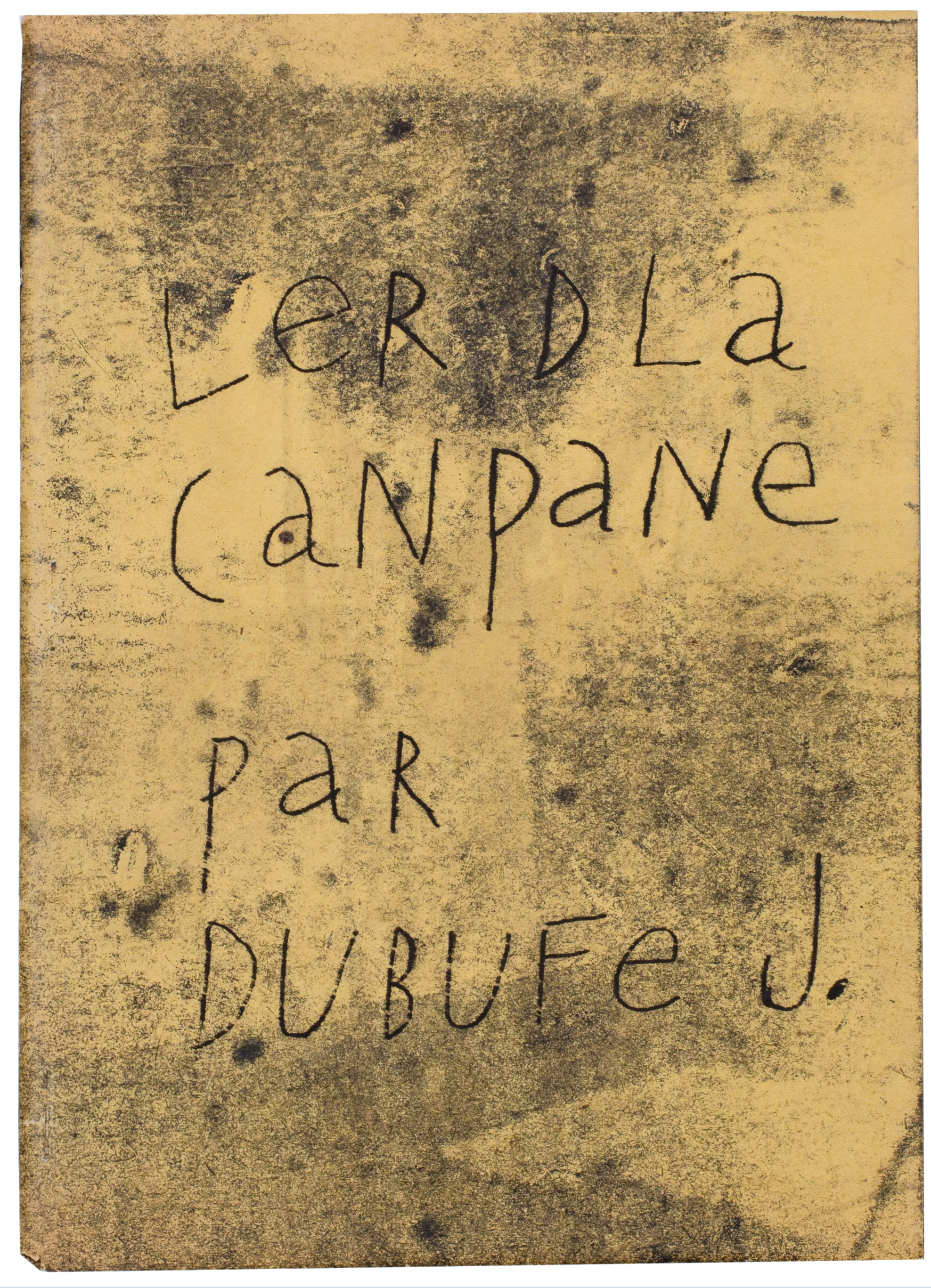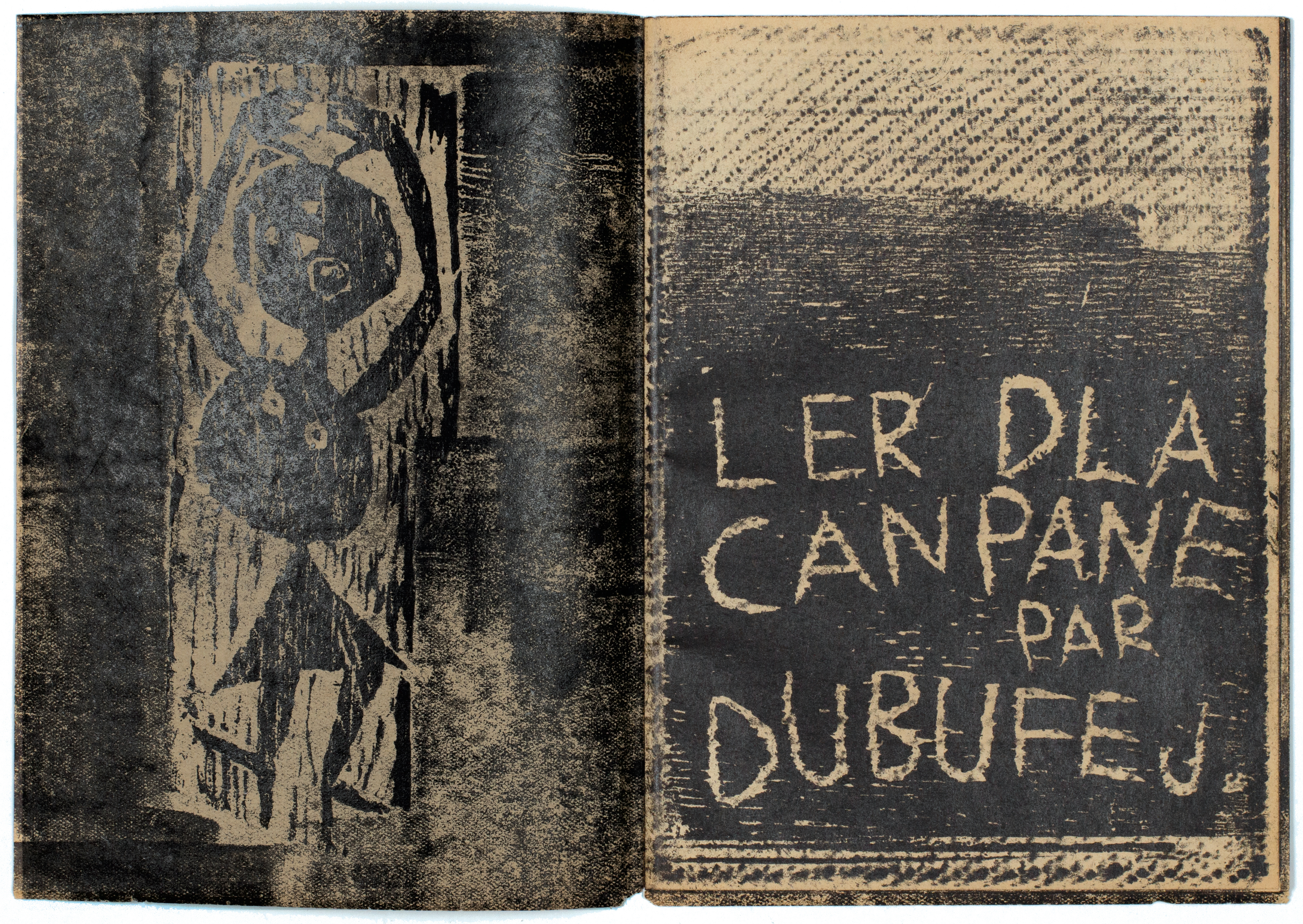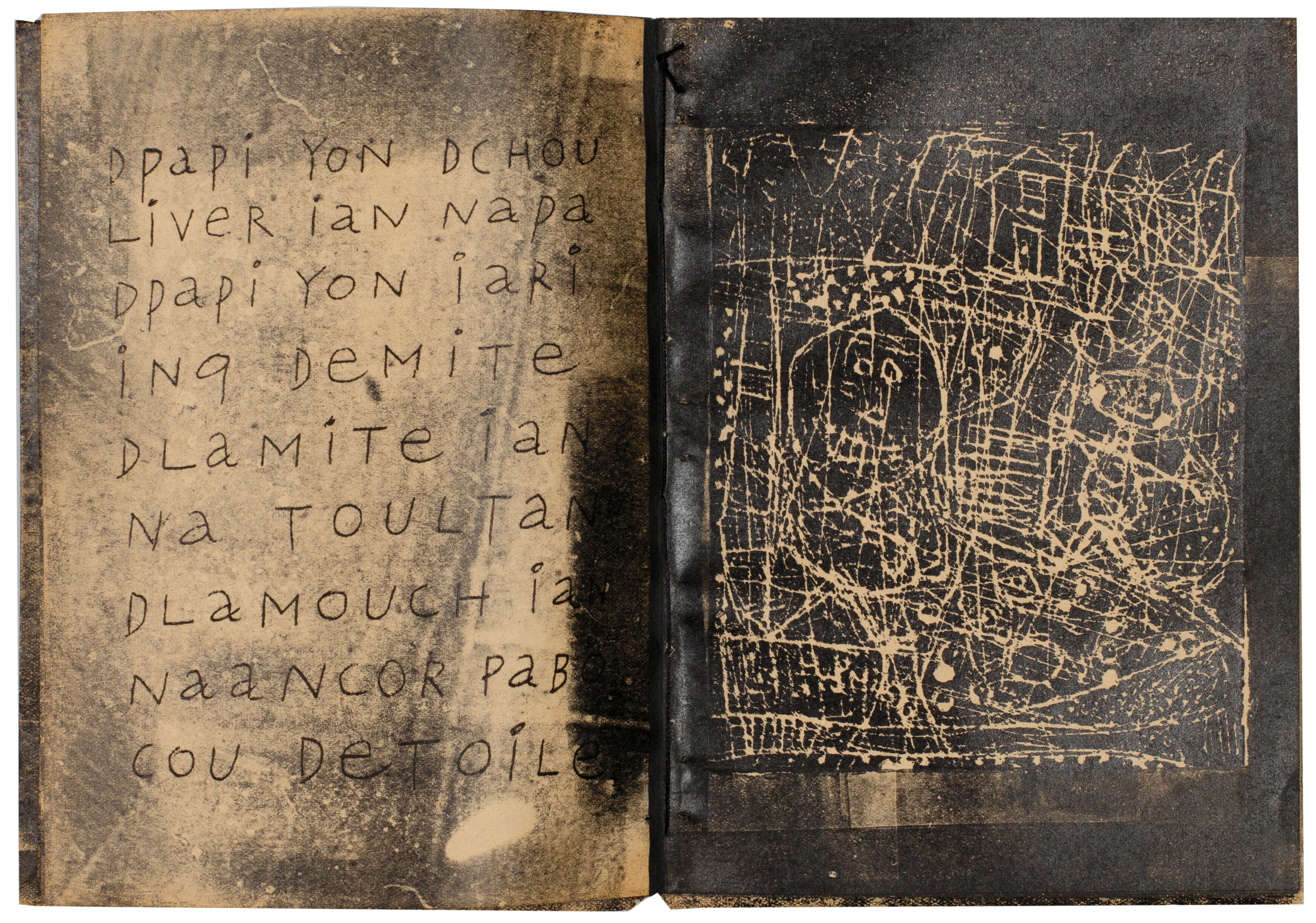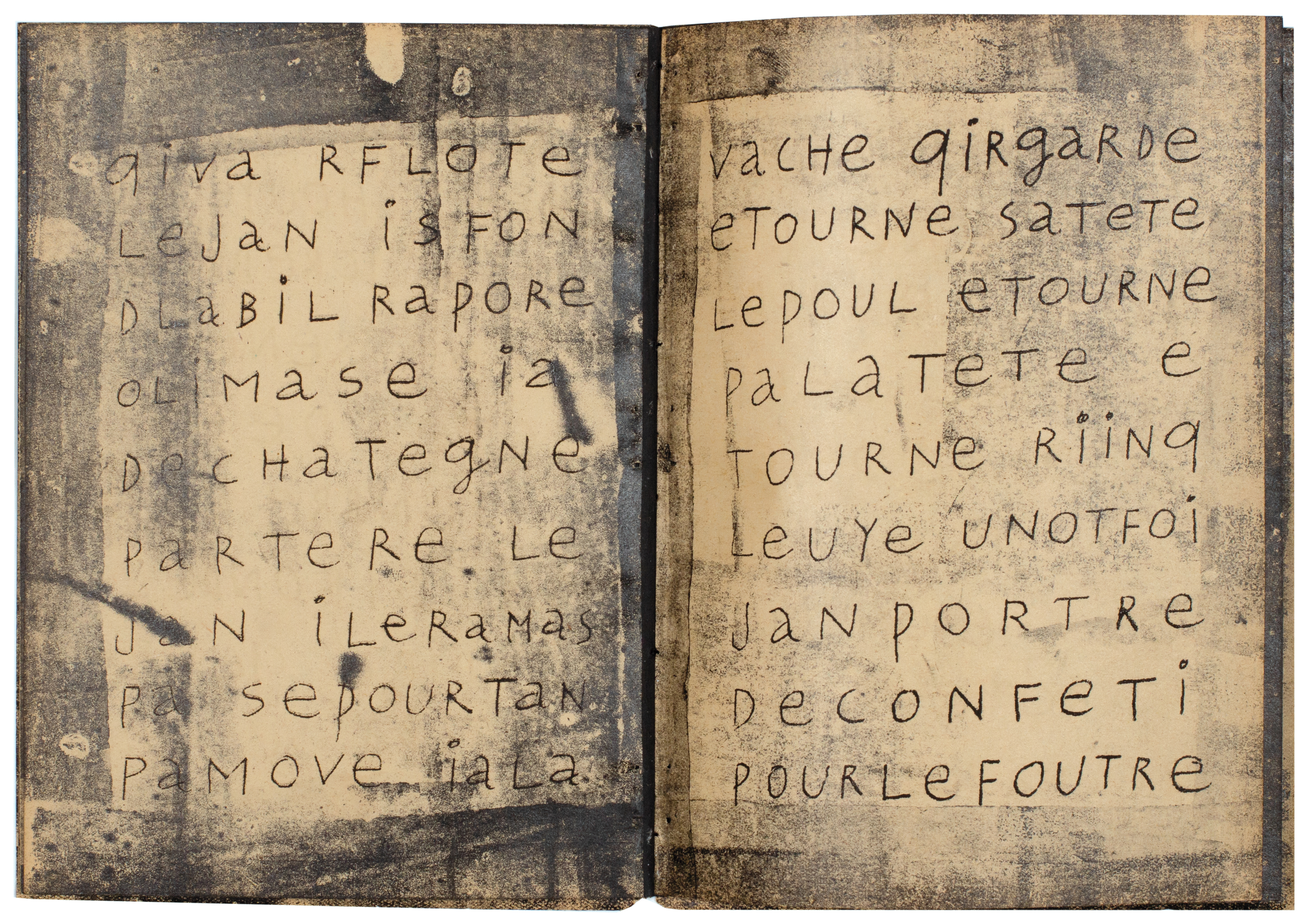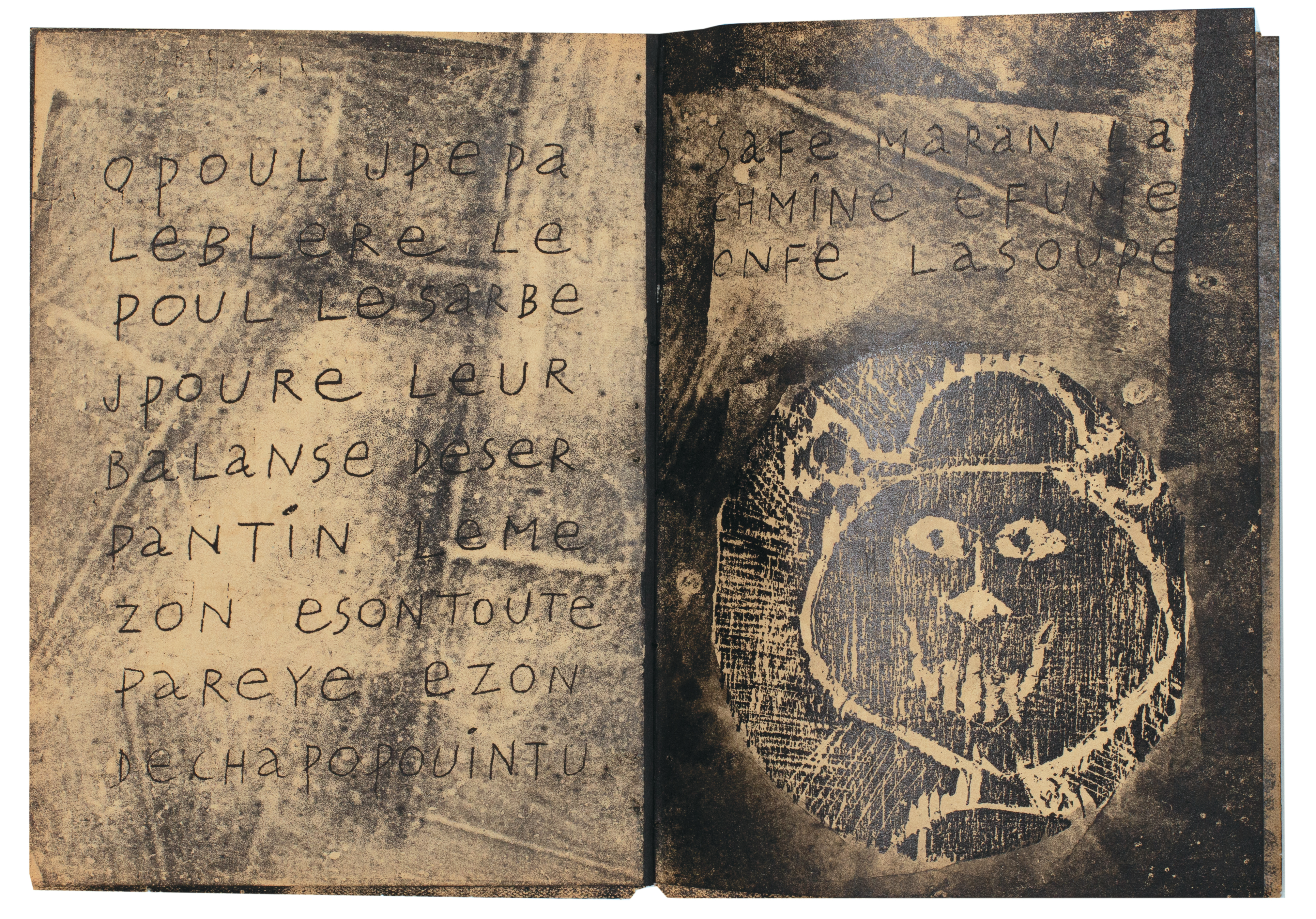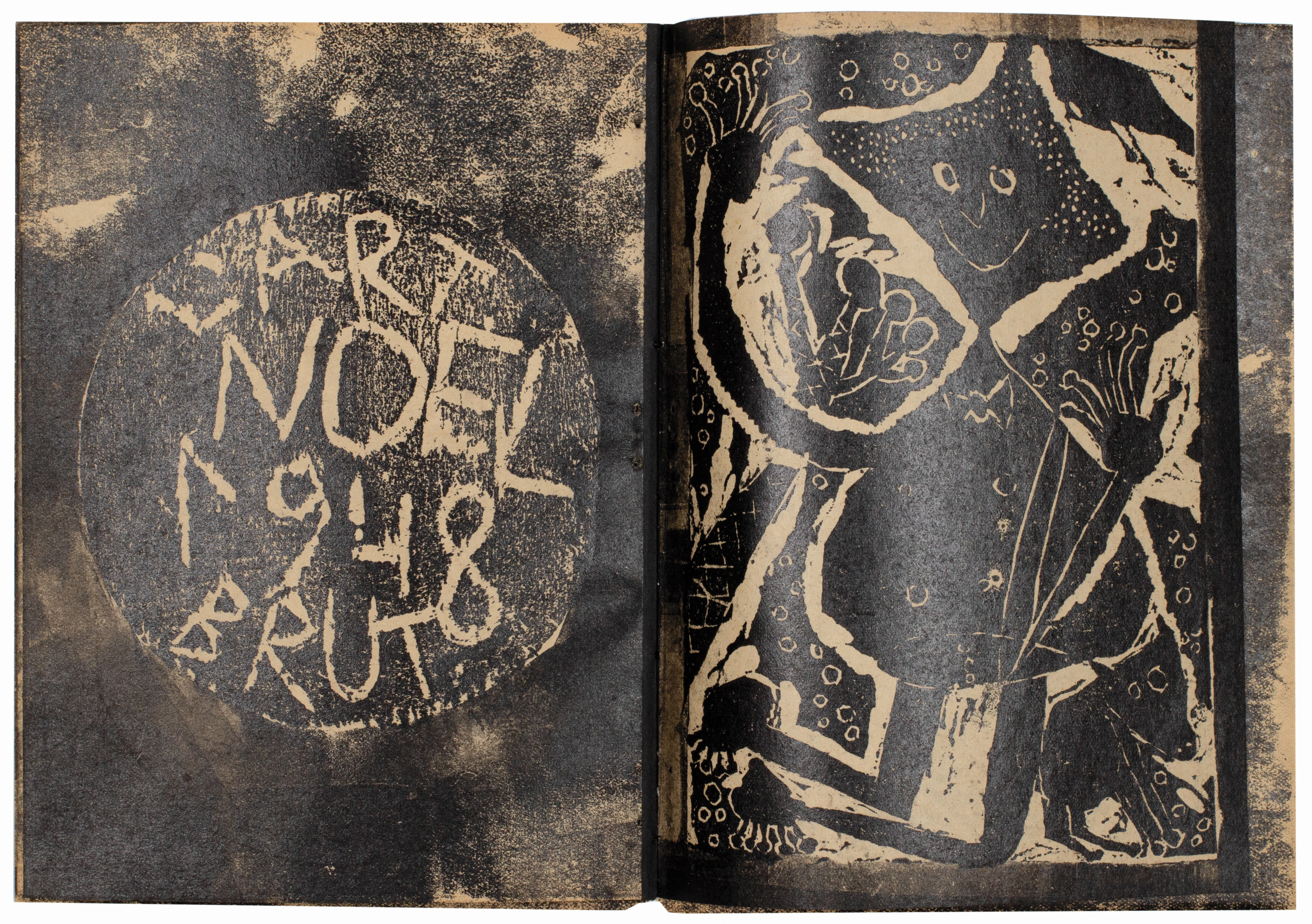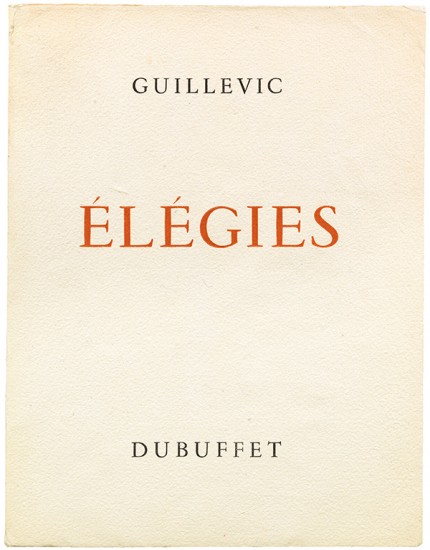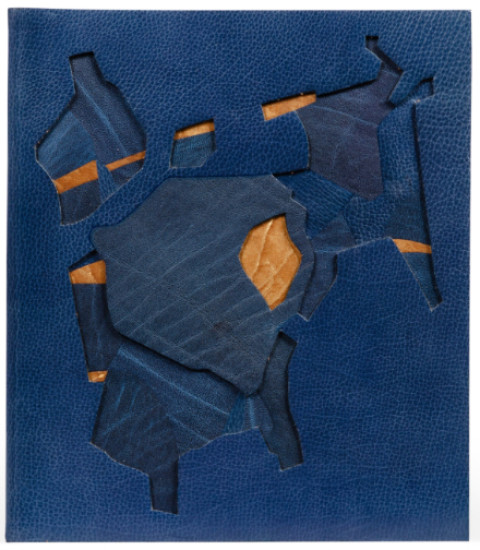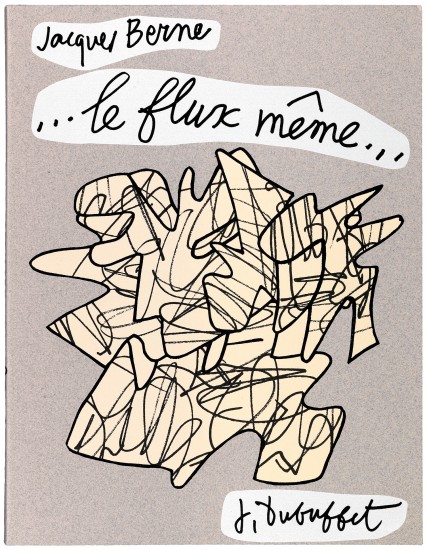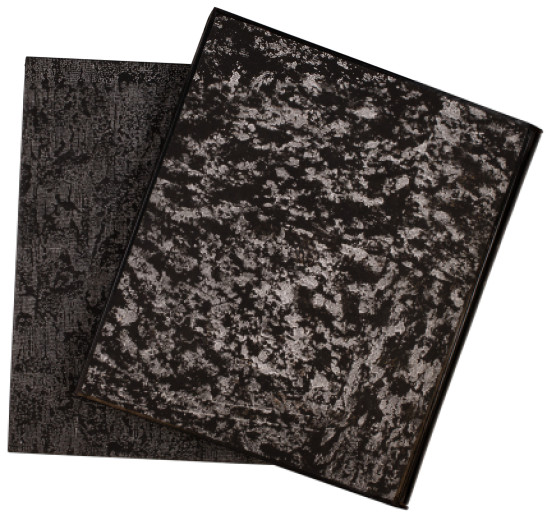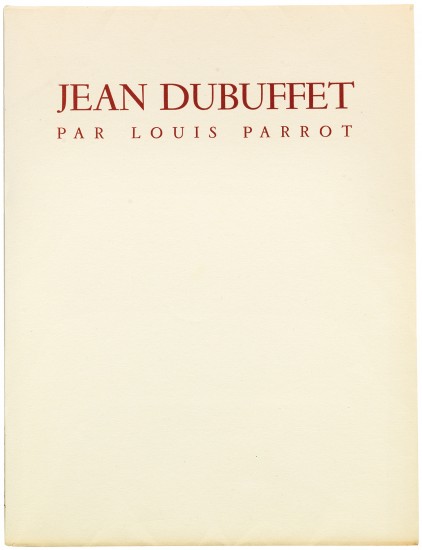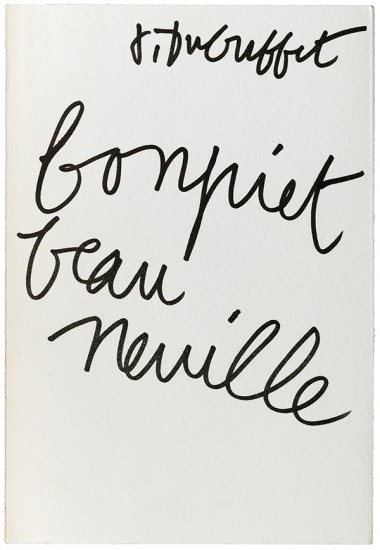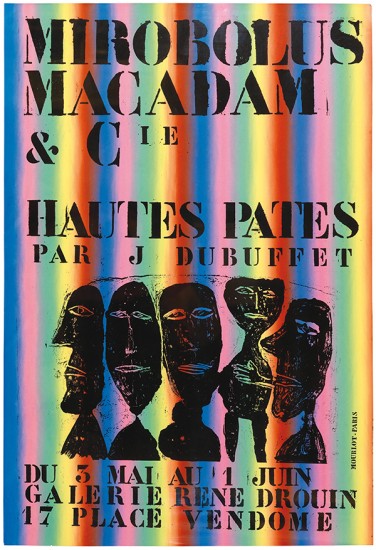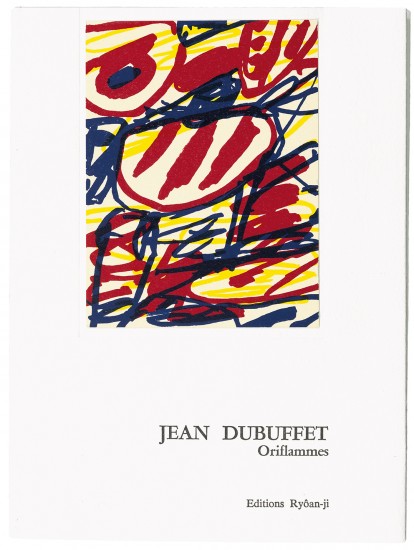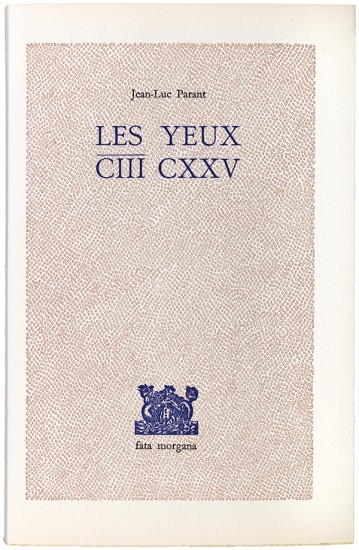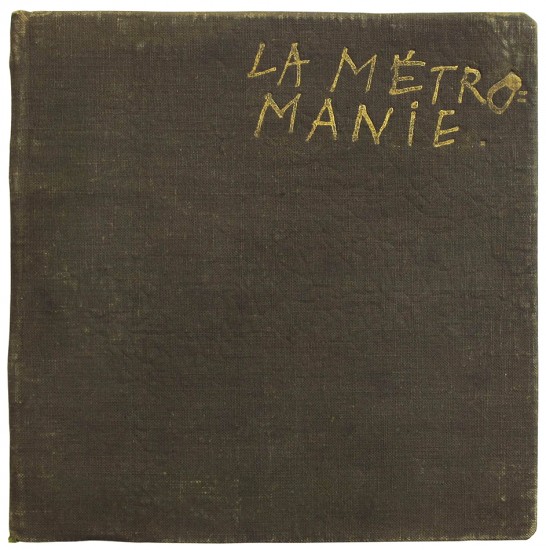LeR DLa CaNpaNe paR DUBUFe J
Dubuffet, Jean
Paris. L'art brut. noël 1948
An excellent copy of the édition de tête of 'LeR DLa CaNpaNe', Dubuffet's first artist book, his own printing of his own illustrations and his own text, in this tirage de tête with each copy unique.
From the edition limited to 165 copies, with this one of 15 copies from the édition de tête on papier journal maculés au rouleau encreur signed and numbered by Dubuffet in black ink to the justification.
The édition de tête, printed like the normal edition by Dubuffet and his wife by hand, differs greatly from the ordinary edition: it features a title, more leaves, additional illustration, frottage to the text and blanks, as well as an extraordinary patina to each page and the covers themselves produced by overprinting with the rouleau encreur. Each copy of this highly restricted tirage is necessarily unique as each was prepared and 'maculé' by Dubuffet by hand with the result that there is extensive variation in the inking and printing especially to the blank leaves and margins; in this example the order of the text and plates differs to that of Webel and pages and 8 and 9 (with the lithograph 'Paysage Champêtre avec Deux Personnes' and the page of text beginning 'DTERE PARTOU') are transposed.
Dubuffet's text is full of nonsense and intentional misspellings - the title is Dubuffet's phonetic version of 'l'air de la campagne' - that reflect the lively child-like illustrations. Executed on linoleum, on strips of wood from packing cases or on the circular bases of Camembert cheese containers (see below), these illustrations reflect Dubuffet's position as an outsider. He was an outsider too in his determination to produce a book as unlike the luxurious livres d'artistes produced by his peers and published by the establishment from which he was so keen to distance himself. LeR DLa CaNpaNe is the first publication of Dubuffet's l'art brut imprint.
'Elles étaient gravées sur des supports grotesques: linoléum, bois de caisse, de boîtes de cirage, ou fonds de boîtes de camembert.' (Dubuffet).
'Premier véritable livre de Dubuffet, écrit selon l'orthographe phonétique et truculente qu'il affectionna, illustré, imprimé et publié par lui ... '. (Antoine Coron).
Jean Dubuffet began his book-making oeuvre with three triumphant argotic texts, all with the text reproduced in his own orthography and each written in a specific phonetic French of his own invention - syllabic sounds reproduced with alternative letters and groups of letters, words and sentences elided and unpunctuated - beginning with this, 'LeR DLa CaNpaNe', issued for Noël in 1948. The second of the trilogy, 'anvouaiaje par in ninbesil avec de zimaje', was printed almost exactly a year later and issued in January 1950. The final part, 'labonfam abeber par inbo nom' with illustration of 1949, was issued in spring 1950. These three publications, artist books that amount to anti-livres d'artistes in their conception and production, represent a tour de force of imagination, experiment, mise en page, format and execution.
'LER DLA CANPANE fut tiré par moi avec l'aide de ma femme, page après page, sur la table de la salle à manger prestement débarrassée après les repas ... sans autre machine que le plat de la main pour les gravures, et, pour les pages de texte, un rudimentaire stencil (fine grille de soie tendue dans un petit cadre) sur lequel j'écrivais avec une pointe. D'où une impression, comme on peut penser, assez barbare.' (J. Dubuffet, writing in the introduction to 'Vignettes Lorgnettes').
The details of the printing of each leaf of text or illustration, pace Webel, are as follows:
- 'Couverture - Ler dla canpane - titre autographié sur stencil et maculé au rouleau - décembre 1948';
- 'Planche I, deuxième de couverture ' Danseuse - gravure sur feuillard de placage';
- 'Page de titre, page 1 - Ler dla canpane - gravure sur fond de boîte de cirage';
- 'Planche III, page 3 - Tireur de langue - gravure sur fond de boîte de cirage';
- 'Planche IV, page 4 - Egzanpler - justification';
- 'Planche V, page 5 - Trois personnages - gravure sur fond de boîte de camembert';
- (page 6 / page 7 - texte autographié sur stencil et maculé au rouleau);
- (page 8- texte autographié sur stencil et maculé au rouleau);
- 'Planche VI, page 9 [this plate and the preceding page are reversed in the present copy] - Paysage champêtre avec deux personnages - gravure sur linoléum';
- (page 10 / page 11 - texte autographié sur stencil et maculé au rouleau);
- (page 12 - texte autographié sur stencil et maculé au rouleau);
- Planche VII, page 13 - Paysage avec deux personnages - gravure sur linoléum';
- (page 13 / page 14 - texte autographié sur stencil et maculé au rouleau);
- 'Planche VIII, page 16 - Paysage avec personnage et animal - gravure sur linoléum';
- (page 17 - texte autographié sur stencil et maculé au rouleau);
- (page 18 / page 19 - texte autographié sur stencil et maculé au rouleau);
- (page 20 - texte autographié sur stencil et maculé au rouleau);
- 'Planche IX, page 21 - Tête au chapeau melon - gravure sur fond de boîte de camembert';
- 'Planche X, page 22 - Noël 1948, l'Art brut' - gravure sur fond de boîte de camembert';
- 'Planche XI, page 23 - Personnage et chien - gravure sur linoléum';
- 'Planche II, 3eme de couverture [a repeat] - gravure sur feuillard de placage'.
[Webel 124 - 148; Dubuffet CR IV, 239 - 250].
From the edition limited to 165 copies, with this one of 15 copies from the édition de tête on papier journal maculés au rouleau encreur signed and numbered by Dubuffet in black ink to the justification.
The édition de tête, printed like the normal edition by Dubuffet and his wife by hand, differs greatly from the ordinary edition: it features a title, more leaves, additional illustration, frottage to the text and blanks, as well as an extraordinary patina to each page and the covers themselves produced by overprinting with the rouleau encreur. Each copy of this highly restricted tirage is necessarily unique as each was prepared and 'maculé' by Dubuffet by hand with the result that there is extensive variation in the inking and printing especially to the blank leaves and margins; in this example the order of the text and plates differs to that of Webel and pages and 8 and 9 (with the lithograph 'Paysage Champêtre avec Deux Personnes' and the page of text beginning 'DTERE PARTOU') are transposed.
Dubuffet's text is full of nonsense and intentional misspellings - the title is Dubuffet's phonetic version of 'l'air de la campagne' - that reflect the lively child-like illustrations. Executed on linoleum, on strips of wood from packing cases or on the circular bases of Camembert cheese containers (see below), these illustrations reflect Dubuffet's position as an outsider. He was an outsider too in his determination to produce a book as unlike the luxurious livres d'artistes produced by his peers and published by the establishment from which he was so keen to distance himself. LeR DLa CaNpaNe is the first publication of Dubuffet's l'art brut imprint.
'Elles étaient gravées sur des supports grotesques: linoléum, bois de caisse, de boîtes de cirage, ou fonds de boîtes de camembert.' (Dubuffet).
'Premier véritable livre de Dubuffet, écrit selon l'orthographe phonétique et truculente qu'il affectionna, illustré, imprimé et publié par lui ... '. (Antoine Coron).
Jean Dubuffet began his book-making oeuvre with three triumphant argotic texts, all with the text reproduced in his own orthography and each written in a specific phonetic French of his own invention - syllabic sounds reproduced with alternative letters and groups of letters, words and sentences elided and unpunctuated - beginning with this, 'LeR DLa CaNpaNe', issued for Noël in 1948. The second of the trilogy, 'anvouaiaje par in ninbesil avec de zimaje', was printed almost exactly a year later and issued in January 1950. The final part, 'labonfam abeber par inbo nom' with illustration of 1949, was issued in spring 1950. These three publications, artist books that amount to anti-livres d'artistes in their conception and production, represent a tour de force of imagination, experiment, mise en page, format and execution.
'LER DLA CANPANE fut tiré par moi avec l'aide de ma femme, page après page, sur la table de la salle à manger prestement débarrassée après les repas ... sans autre machine que le plat de la main pour les gravures, et, pour les pages de texte, un rudimentaire stencil (fine grille de soie tendue dans un petit cadre) sur lequel j'écrivais avec une pointe. D'où une impression, comme on peut penser, assez barbare.' (J. Dubuffet, writing in the introduction to 'Vignettes Lorgnettes').
The details of the printing of each leaf of text or illustration, pace Webel, are as follows:
- 'Couverture - Ler dla canpane - titre autographié sur stencil et maculé au rouleau - décembre 1948';
- 'Planche I, deuxième de couverture ' Danseuse - gravure sur feuillard de placage';
- 'Page de titre, page 1 - Ler dla canpane - gravure sur fond de boîte de cirage';
- 'Planche III, page 3 - Tireur de langue - gravure sur fond de boîte de cirage';
- 'Planche IV, page 4 - Egzanpler - justification';
- 'Planche V, page 5 - Trois personnages - gravure sur fond de boîte de camembert';
- (page 6 / page 7 - texte autographié sur stencil et maculé au rouleau);
- (page 8- texte autographié sur stencil et maculé au rouleau);
- 'Planche VI, page 9 [this plate and the preceding page are reversed in the present copy] - Paysage champêtre avec deux personnages - gravure sur linoléum';
- (page 10 / page 11 - texte autographié sur stencil et maculé au rouleau);
- (page 12 - texte autographié sur stencil et maculé au rouleau);
- Planche VII, page 13 - Paysage avec deux personnages - gravure sur linoléum';
- (page 13 / page 14 - texte autographié sur stencil et maculé au rouleau);
- 'Planche VIII, page 16 - Paysage avec personnage et animal - gravure sur linoléum';
- (page 17 - texte autographié sur stencil et maculé au rouleau);
- (page 18 / page 19 - texte autographié sur stencil et maculé au rouleau);
- (page 20 - texte autographié sur stencil et maculé au rouleau);
- 'Planche IX, page 21 - Tête au chapeau melon - gravure sur fond de boîte de camembert';
- 'Planche X, page 22 - Noël 1948, l'Art brut' - gravure sur fond de boîte de camembert';
- 'Planche XI, page 23 - Personnage et chien - gravure sur linoléum';
- 'Planche II, 3eme de couverture [a repeat] - gravure sur feuillard de placage'.
[Webel 124 - 148; Dubuffet CR IV, 239 - 250].
[Bifolium (wrapper) + 6 bifolia: 12 unnumbered leaves]. 12mo. (189 x 136 mm). Title to front wrapper, engraving verso, leaf with title, leaf with frontispiece, justification verso, leaf with dedication and vignette (‘a JaNLaNSeLM’), stencil text verso, 7 leaves with stencil text and illustration, leaf with conclusion of text and vignette, 'achevé d'imprimer' verso, final leaf with illustration recto and decoration verso, illustration to recto of rear wrapper; the 9 illustrations are linoleum cuts and woodcuts printed using camembert boxes and packing cases, all leaves with ‘maculé’ overprinting, frottage and grattage in heavy black ink. Original publisher’s printed wrappers, printed titles and ‘maculé’ printing to covers, wrapper interiors with printed illustration, later black paper-lined black calf-backed grey marbled paper board chemise by J-P Miguet with his signature, gilt title to spine, matching black calf-edged slipcase.
#48672
